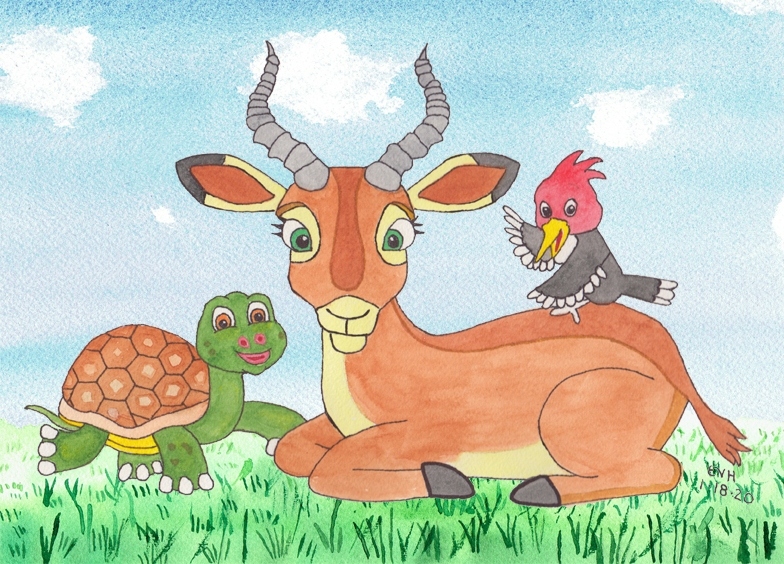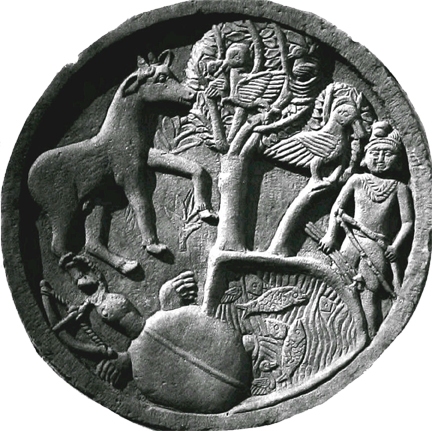
Jataka 206
Kuruṇga Miga Jātaka
The Antelope’s Friends
as told by Eric Van Horn
originally translated by William Henry Denham Rouse, Cambridge University
originally edited by Professor Edward Byles Cowell, Cambridge University
This Jātaka is famous for being featured in a relief at the Bharhut Stupa in central India. The original stupa was (probably) built at the beginning of the reign of the famous Buddhist king, King Asoka, around 125-100 BCE. The stupa was subsequently lost to history, but was rediscovered by the British archeologist Arthur Cunningham in 1873. Most of the Bharhut Stupa is now in the Indian Museum in Kolkata (Calcutta).
This is another story about friendship. It is one of my favorite classes of Jātaka stories.
“Come, Tortoise.” The Master told this story while he was at Veḷuvana (the “Bamboo Grove” Monastery in Rajagraha, modern day Rajgir). It is about Devadatta. News came to the Master that Devadatta was plotting his death. “Ah, monks,” he said, “it was just the same long ago. Devadatta tried then to kill me, as he is trying to do so now.” And he told them this story from the past.
Once upon a time, when Brahmadatta was King of Benares, the Bodhisatta was reborn as an antelope. He lived in a forest, in a thicket near a certain lake. Not far from that lake a woodpecker sat at the top of a tree, and there was a tortoise who lived in the lake. The three of them became friends, and they lived together in harmony.
One day a hunter was wandering about in the woods, and he saw the Bodhisatta’s footprint leading down into the water. He set a trap of leather, strong, like an iron chain, and then he went on his way. In the first watch of the night the Bodhisatta went down to the lake to drink, and he got caught in the noose. He cried loud and long. The woodpecker flew down from her tree top, and the tortoise came out of the water. When they saw the situation, they discussed what to do about it.
The woodpecker said to the tortoise, “Friend, you have teeth. Bite through the snare. Meanwhile, I will go and make sure that the hunter stays away. If we both do our best, our friend will not lose his life.” To make this clear he uttered the first stanza:
“Come, tortoise, tear the leather snare, and bite it through and through,
And of the hunter I’ll take care, and keep him off from you.”
The tortoise began to gnaw the leather thong. The woodpecker made his way to the hunter’s hut. At the dawn of day the hunter went out, knife in hand. As soon as the bird saw him, he uttered a cry, flapped his wings, and struck him in the face as he walked out the front door. “Some evil bird has struck me!” the hunter thought. He turned back and lay down for a little while. Then he got up and once again took his knife. The bird thought to himself, “The first time he went out by the front door so now he will leave by the back.” So he sat down behind the house. The hunter, too, reasoned in the same way. “When I went out by the front door, I saw an evil bird. Now will I go out by the back!" And so he did. But the bird cried out and struck him in the face again. Finding that he was once again struck by an evil bird, the hunter exclaimed, “This creature will not let me go!” And he turned back and lay down until sunrise. And when the sun had risen, he took his knife and started out.
The woodpecker rushed back to his friends. “Here comes the hunter!” he cried. By this time the tortoise had gnawed through all the thongs except for an especially tough one. His teeth seemed as though they would fall out, and his mouth was all covered with blood. The Bodhisatta saw the young hunter coming on like lightning, knife in hand. He managed to burst the thong and fled into the woods. The woodpecker flew up to his tree top. But the tortoise was so weak that he just lay where he was. The hunter threw him into a bag and tied it to a tree.
The Bodhisatta saw that the tortoise had been taken, and he was determined to save his friend’s life. So he let the hunter see him and acted as though he were weak. The hunter saw him and thinking him to be weak, he grabbed his knife and set out in pursuit. The Bodhisatta, keeping just out of his reach, led him into the forest. And when he saw that they had traveled a long way, he gave him the slip and returned as swiftly as the wind by a different way. He lifted the bag with his horns, threw it on the ground, ripped it open and let the tortoise out. Meanwhile the woodpecker flew down from the tree.
Then the Bodhisatta addressed them both: “My life has been saved by you, and you have been a good friend to me. Now the hunter will come to take you. So you, friend woodpecker, fly elsewhere with your brood, and you, friend tortoise, dive into the water.” And so they did.

Figure: Living Together in Harmony
The Master, becoming perfectly serene, uttered the second stanza:
“The tortoise went into the pond, the deer into the wood,
And from the tree the woodpecker carried away his brood.”
The hunter returned and did not see any of them. He found his bag torn. He picked it up and went home sorrowful. And the three friends lived all their lives in unbroken harmony, and then passed away to fare according to their karma.
When the Master had ended this discourse, he identified the birth: “Devadatta was the huntsman, Sāriputta was the woodpecker, Moggallāna the tortoise, and I was the antelope."

Figure: The Relief of Kuruṇga Miga Jātaka from Bharhut Stupa
